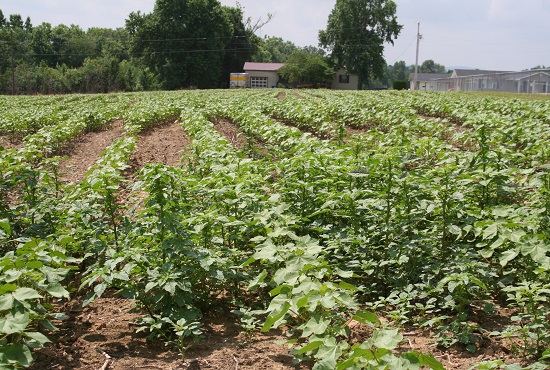The Struggle of Egyptian Cotton
Before the start of the world financial crisis in November of 2008, the marketing policy for Egyptian cotton during 2008/09 were characterized by a few different elements.
First, the Egyptian cotton production had decreased to the lowest level since 1900. Only 105,000 tons were produced against 227,000 tons during the 2007/08 season with the reduction ratio amounting to 54%, approximately.
Second, with this decrease in production, all indicators ensure that the purchase price offered by the producers will increase due to the decrease in the amount available for sale and the increase in production cost in comparison with substitute crops. Also it happened that the purchase price at the starting of the season was higher than that of the last season by 30%.
Third, the predicted export selling price was increasing to a level higher than that of the last season (2007/08) with the same ratio of 30%. But the demand for exports started to decrease because the international mills which use the Egyptian cotton have imported most of their needs up until March 2007, or even more at lower prices.
Fourth and finally, this increase comes along with the competitive cotton prices in the international market, like the U.S. Pima cotton and also the foreign short cotton prices which Egypt imports (such as the Greek and C.I.S. cotton, and index A,B prices).
COMPARATIVE PRODUCTION
|
Season |
Production Thousand Tons |
Season |
Production Thousand Tons |
| 1900/1901 | 272 | 1980/1981 | 529 |
| 1920/1921 | 302 | 1990/1991 | 296 |
| 1930/1931 | 414 | 2000/2001 | 210 |
| 1940/1941 | 450 | 2005/2006 | 204 |
| 1950/1951 | 415 | 2006/2007 | 215 |
| 1960/1961 | 522 | 2007/2008 | 226 |
| 1070/1971 | 509 | 2008/2009 | 106 |
|
Season 2008/2009 |
Season 2008/2009 from 1/9/08-12/2/09 Tons |
Commitment & shipped ratio % |
|
| Commitments | 11,708.00 | 1,105,827.70 | 10.10% |
| Shipped | 4,450.00 | 48,364.05 | 9.20% |
* Source: Alexandria cotton exporters Association (ALCOTEXA)
| Season 2008/2009 from 1/9/08-12/2/09 Tons |
Season 2007/2008 |
Ratio between 2008/2009 & 2007/2008 % |
|
| Egyptian cotton receiving by Egyptian spinning mills |
16,220 | 62,148 | 26% |
* Source: Cotton spinning, weaving & garments holding CO.
The result of the present financial crisis on the economy of the developing countries has been severe. There is no doubt that the developing and poor countries, specifically in African countries such as Egypt and the Arab zone, will suffer from the negative effects of the financial crisis. These nations will suffer most from the decrease in their exports; industrialized countries are affected by the economic depression and have stopped buying goods imported from the developing nations. We have seen a decrease in liquidity and increase in cost.
About 30% of the total labor in the Egyptian industry is in the spinning and weaving industry (about 1 million workers). This percentage of the work force was giving returns by exporting about 3 billion Egyptian pounds (EGP) yearly. This was expected to increase to 3 billion U.S. dollars during the coming period (1 U.S. dollar is equivalent to 5.5 EGP), but then the financial crisis came. Disappointingly, it is now expected that the rate of growth will be between 3-4% in comparison with the 7.2% growth in 2008 in Egypt.
We have seen a decrease in liquidity and increase in cost. The size of the Egyptian exports of weaving products does not represent more than 1% of the size of the world weaving trade. This small market share is a result of the weakness in the demand for clothes; the American and European markets are looking for the cheapest products due to the stagnation resulting from the financial crisis. As for the exports of Egyptian cotton in this season, all indicators ensure that the decrease will be very clear in comparison with the last 2007/08 season.
The Egyptian spinning mills that use Egyptian cotton will also be affected by the financial crisis. Their receiving of cotton during 2008/09 will decrease in comparison with their receiving of cotton during the 2007/08 season.
Concerning the Egyptian cotton production estimation for 2009/10, it is expected that there will be a decrease in the cultivated area. Planting is not expected to reach the same standard of the recent 2008/09 year which had 316,000 Feddan. There was an optimistic possibility that planting could increase to about 360,000 Feddan (as a maximum), but reports indicate that until now (March 2009) there were no traces of any cultivation for cotton in Egypt.
As for the international production standard for all types of cotton, especially for the ELS cotton, it must be clear that, due to the present international economic situation, the cultivated area all over the world will decrease by 30% to 40%, as the ICAC reports. But some optimistic indicators show that the price of cotton will increase after a period of 6 to 12 months due to the decrease in offers for cotton in the coming year. In the case that producers decrease their production, or in the case of a better economic situation which would increase the cotton demand, price will respond positively.








